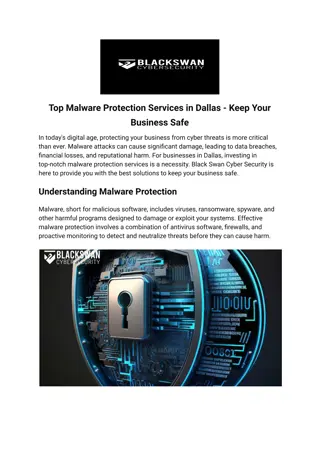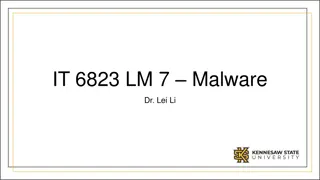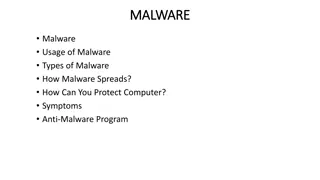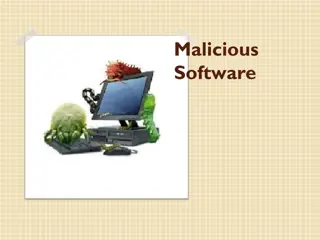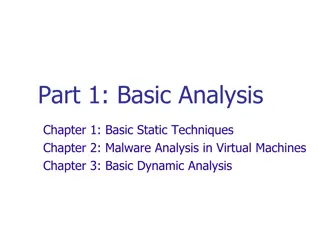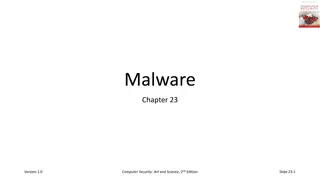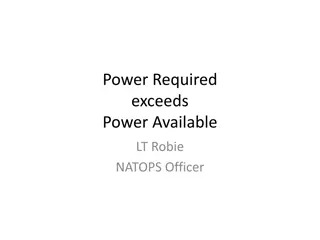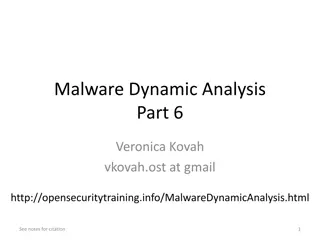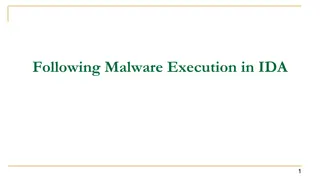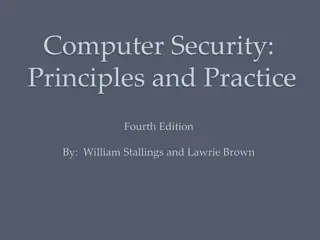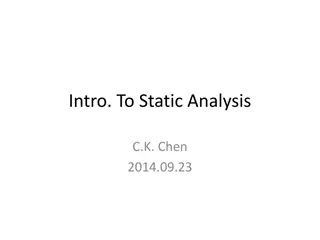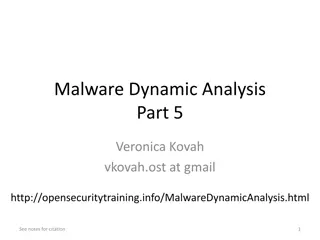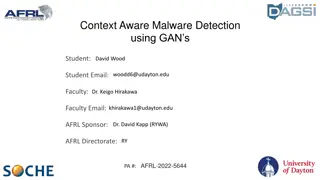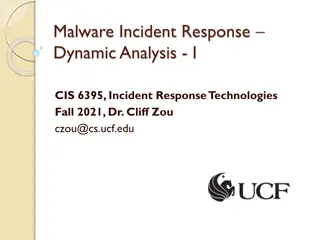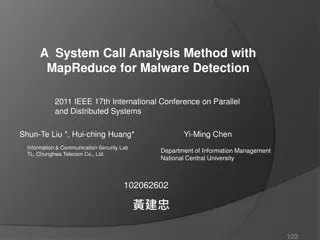Malware Dynamic Analysis Part 3: Maneuvering Techniques
This content explores the strategic positioning of malware to access critical resources, focusing on DLL/code injection, DLL search order hijacking, keylogging, and more. Learn about maneuvering methods like DLL injection, code injection, and APC injection. Dive into observing Parite's maneuvering using Regshot and discover the answers for the Parite Lab questions.
Download Presentation

Please find below an Image/Link to download the presentation.
The content on the website is provided AS IS for your information and personal use only. It may not be sold, licensed, or shared on other websites without obtaining consent from the author.If you encounter any issues during the download, it is possible that the publisher has removed the file from their server.
You are allowed to download the files provided on this website for personal or commercial use, subject to the condition that they are used lawfully. All files are the property of their respective owners.
The content on the website is provided AS IS for your information and personal use only. It may not be sold, licensed, or shared on other websites without obtaining consent from the author.
E N D
Presentation Transcript
Malware Dynamic Analysis Part 3 Veronica Kovah vkovah.ost at gmail http://opensecuritytraining.info/MalwareDynamicAnalysis.html See notes for citation 1
All materials is licensed under a Creative Commons Share Alike license http://creativecommons.org/licenses/by-sa/3.0/ See notes for citation 2
Where are we at? Part 3: Maneuvering techniques (How malware strategically positions itself to access critical resources) DLL/code injection DLL search order hijacking... Part 4: Malware functionality Keylogging, Phone home, Security degrading, Self- destruction, etc. See notes for citation 3
Maneuvering DLL injection Direct code injection DLL search order hijacking Asynchronous Procedure Call (APC) injection IAT/EAT hooking Inline hooking See notes for citation 4
DLL/code Injection Load a malicious DLL/code into one or more processes Run malicious code on behalf of a legitimate process Bypass host-based security software HIDS, Personal Firewall See notes for citation 5
DLL Injection Methods (1) AppInit_DLLs HKLM\Software\Microsoft\Windows NT\CurrentVersion\Windows\AppInit_DLLs is set to a space or comma separated list of DLLs to load into processes that load user32.dll On Windows Vista and newer you also have to set a few other values in that path like LoadAppInit_DLLs = 1 and RequireSignedAppInit_DLLs = 0 See notes for citation 6
Observing Parite's Maneuvering Using Regshot on the victim VM 1) Start Regshot (MalwareClass/tools/v5_regshot_1.8.3...) 2) Click 1st shotbutton Shot 3) Run parite/malware.exe 4) Click 2nd shotbutton Shot 5) Click Compare button Q1. Which DLL is used for maneuvering? Q2. Where is it maneuvering? Q3. Open question: Any theories why it s maneuvering to there? See notes for citation 7
Answers for Parite Lab A1. fmsiopcps.dll is added to HKLM\Software\Microsoft\Windows NT\CurrentVersion\Windows\AppInit_DLLs A2. All Windows applications, which use user32.dll See notes for citation 8
Application Programming Interface (API) Specifies a software component in terms of its operations, their inputs and outputs and underling types http://en.wikipedia.org/wiki/Application_programming_interface char *strncpy(char *dest, const char *src, size_t n); 3 inputs: dest: destination string src: source string n: number of characters to copy from source string 1 output: returns a pointer to the destination string See notes for citation 9
DLL Injection Methods (2) CreateRemoteThread Windows API Manipulate a victim process to call LoadLibrary with the malicious DLL name Malicious code is located in DllMain, which is called once a DLL is loaded into memory A common API call pattern: OpenProcess VirtualAllocEx WriteProcessMemory GetModuleHandle GetProcAddress CreateRemoteThread Also, a direct code injection method See notes for citation 10
OpenProcessVirtualAllocEx WriteProcessMemory GetModuleHandle GetProcAddress CreateRemoteThread HANDLE WINAPI OpenProcess( _In_ DWORD dwDesiredAccess, _In_ BOOL bInheritHandle, _In_ DWORD dwProcessId ); dwProcessId [in] The identifier of the local process to be opened... Return value If the function succeeds, the return value is an open handle to the specified process See notes for citation 11
OpenProcessVirtualAllocEx WriteProcessMemory GetModuleHandle GetProcAddress CreateRemoteThread LPVOID WINAPI VirtualAllocEx( _In_ HANDLE hProcess, _In_opt_ LPVOID lpAddress, _In_ SIZE_T dwSize, _In_ DWORD flAllocationType, _In_ DWORD flProtect ); hProcess [in] The handle to a process. The function allocates memory within the virtual address space of this process... dwSize [in] The size of the region of memory to allocate, in bytes... Return value If the function succeeds, the return value is the base address of the allocated region of pages... See notes for citation 12
OpenProcessVirtualAllocEx WriteProcessMemory GetModuleHandle GetProcAddress CreateRemoteThread BOOL WINAPI WriteProcessMemory( _In_ HANDLE hProcess, _In_ LPVOID lpBaseAddress, _In_ LPCVOID lpBuffer, _In_ SIZE_T nSize, _Out_ SIZE_T *lpNumberOfBytesWritten ); hProcess [in] A handle to the process memory to be modified lpBaseAddress [in] A pointer to the base address in the specified process to which data is written lpBuffer [in] A pointer to the buffer that contains data to be written in the address space of the specified process. nSize [in] The number of bytes to be written to the specified process. See notes for citation 13
OpenProcessVirtualAllocEx WriteProcessMemory GetModuleHandle GetProcAddress CreateRemoteThread HMODULE WINAPI GetModuleHandle( _In_opt_ LPCTSTR lpModuleName ); pModuleName [in, optional] The name of the loaded module (either a .dll or .exe file) Return value If the function succeeds, the return value is a handle to the specified module See notes for citation 14
OpenProcessVirtualAllocEx WriteProcessMemory GetModuleHandle GetProcAddress CreateRemoteThread FARPROC WINAPI GetProcAddress( _In_ HMODULE hModule, _In_ LPCSTR lpProcName ); hModule [in] A handle to the DLL module that contains the function or variable lpProcName [in] The function or variable name, or the function's ordinal value... Return value If the function succeeds, the return value is the address of the exported function or variable... See notes for citation 15
OpenProcessVirtualAllocEx WriteProcessMemory GetModuleHandle GetProcAddress CreateRemoteThread HANDLE WINAPI CreateRemoteThread( _In_ HANDLE hProcess, _In_ LPSECURITY_ATTRIBUTES lpThreadAttributes, _In_ SIZE_T dwStackSize, _In_ LPTHREAD_START_ROUTINE lpStartAddress, _In_ LPVOID lpParameter, _In_ DWORD dwCreationFlags, _Out_ LPDWORD lpThreadId ); A handle to the process in which the thread is to be created... lpStartAddress [in] A pointer to the application-defined function of type LPTHREAD_START_ROUTINE to be executed by the thread and represents the starting address of the thread in the remote process... lpParameter [in] A pointer to a variable to be passed to the thread function. hProcess [in] See notes for citation 16
CreateRemoteThread() cont. lpStartAddress s type is LPTHREAD_START_ROUTINE, which is defined as typedef DWORD (__stdcall *LPTHREAD_START_ROUTINE) ( [in] LPVOID lpThreadParameter ); You can t put any function as lpStartAddress. It has to be one which matches the above prototype. One (popular) example is HMODULE WINAPI LoadLibrary( _In_ LPCTSTR lpFileName ); See notes for citation 17
DLL Injection API Call Example kernel32.dll LoadLibrary(filename) LoadLibrary(filename) myInjectDll() { } buf = evil.dll malicious process Internet Explorer process PID: 109 See notes for citation 18
DLL Injection API Call Example kernel32.dll LoadLibrary(filename) LoadLibrary(filename) myInjectDll() { h=OpenProcess(,,proc_id) } buf = evil.dll malicious process Internet Explorer process PID: 109 See notes for citation 19
DLL Injection API Call Example kernel32.dll LoadLibrary(filename) LoadLibrary(filename) myInjectDll() { h=OpenProcess(,,proc_id) addr = VirtualAllocEx(h,, size,,) } buf = evil.dll malicious process Internet Explorer process PID: 109 See notes for citation 20
DLL Injection API Call Example kernel32.dll LoadLibrary(filename) LoadLibrary(filename) 0x4000 myInjectDll() { h=OpenProcess(,,proc_id) addr = VirtualAllocEx(h,, size,,) } buf = evil.dll malicious process Internet Explorer process PID: 109 See notes for citation 21
DLL Injection API Call Example kernel32.dll LoadLibrary(filename) LoadLibrary(filename) 0x4000 myInjectDll() { h=OpenProcess(,,proc_id) addr = VirtualAllocEx(h,, size,,) WriteProcessMem(h,addr,buf,size, ) } buf = evil.dll malicious process Internet Explorer process PID: 109 See notes for citation 22
DLL Injection API Call Example kernel32.dll LoadLibrary(filename) LoadLibrary(filename) 0x4000 evil.dll myInjectDll() { h=OpenProcess(,,proc_id) addr = VirtualAllocEx(h,, size,,) WriteProcessMem(h,addr,buf,size, ) } buf = evil.dll malicious process Internet Explorer process PID: 109 See notes for citation 23
DLL Injection API Call Example kernel32.dll LoadLibrary(filename) LoadLibrary(filename) 0x4000 evil.dll myInjectDll() { h=OpenProcess(,,proc_id) addr = VirtualAllocEx(h,, size,,) WriteProcessMem(h,addr,buf,size, ) CreateRemoteThread(h,,,start,param, ) } buf = evil.dll malicious process Internet Explorer process PID: 109 See notes for citation 24
DLL Injection API Call Example kernel32.dll LoadLibrary(filename) LoadLibrary(filename) 0x4000 evil.dll myInjectDll() { h=OpenProcess(,,proc_id) addr = VirtualAllocEx(h,, size,,) WriteProcessMem(h,addr,buf,size, ) CreateRemoteThread(h,,,start,param, ) } buf = evil.dll LoadLibrary( evil.dll ) malicious process Internet Explorer process PID: 109 See notes for citation 25
Observing Onlinegame2 Maneuvering For this lab, we will use WinApiOverride (an API monitor) to analyze onlinegames/2/malware.exe Hint: new process will be invoked Q1. What is the address of LoadLibrary()? Q2. Where is it maneuvering to? Q3. What s the path of the DLL being injected? See notes for citation 26
Answers for Onlinegame2 Lab A1. 0x7C801D7B A2. Explorer.exe, OpenProcess takes PID as its parameter A3. C:\WINDOWS\system32\ailin.dll See notes for citation 27
Observing Onlinegame1 Maneuvering Spot the direct code injection Use WinApiOverride (an API monitor) to analyze onlinegames/1/malware.exe Q1. What is the size of the code being injected? Q2. Where is it maneuvering? Q3. What s the path of DLL being injected? Take a dump of the process using Process Explorer. See notes for citation 28
Answers for Onlinegame1 Lab A1. 0x457 A2. Explorer.exe, OpenProcess takes PID as its parameter A3. C:\Windows\System32\nmdfgds0.dll Process Explorer provides process memory dump. In order to open the dump file, use windbg sFile Open Dump menu option See notes for citation 29
Thread AKA light weight process who has own program counter (EIP), a register set, and a stack Multiple threads can exist in a process and share a process's resources, such as opened file and network connection, concurrently Thread context switching is much cheaper than process context switching See notes for citation 30
Kernel Active Thread Thread1 Context Thread2 Context Current Stack Pointer Stack for Thread1 Stack for Thread2 Heap WickedSweetApp.exe Current Instruction Pointer Ntdll.dll MyLib1.dll MyLib2.dll See notes for citation 31
Kernel Active Thread Thread1 Context Thread2 Context Current Stack Pointer Stack for Thread1 Stack for Thread2 Heap WickedSweetApp.exe Current Instruction Pointer Ntdll.dll MyLib1.dll MyLib2.dll See notes for citation 32
Kernel Active Thread Thread1 Context Thread2 Context Current Stack Pointer Stack for Thread1 Stack for Thread2 Heap WickedSweetApp.exe Current Instruction Pointer Ntdll.dll MyLib1.dll MyLib2.dll See notes for citation 33
Kernel Active Thread Thread1 Context Thread2 Context Stack for Thread1 Current Stack Pointer Stack for Thread2 Heap WickedSweetApp.exe Current Instruction Pointer Ntdll.dll MyLib1.dll MyLib2.dll See notes for citation 34
DLL Injection Methods (3a) SetWindowsHookEX Windows API Monitor certain types of events (e.g. key strokes) HHOOK WINAPI SetWindowsHookEx( _In_ int idHook, _In_ HOOKPROC lpfn, _In_ HINSTANCE hMod, _In_ DWORD dwThreadId ); See notes for citation 35
DLL Injection Methods (3b) If dwThreadId is zero, it injects DLL into memory space of every process in the same Windows desktop (which is a memory organization term, not the desktop you see when looking at your computer) If dwThreadId belongs to another process, it injects DLL into the process For the sake of simple DLL injection, use uncommon message type (e.g. WH_CBT) See notes for citation 36
DLL Injection Methods (4) Codecave (a redirection of program execution to another location and then returning back to the area where program execution had previously left.) Inject a snippet of code, which calls LoadLibrary, to a victim process Suspend a thread in the victim process and restart the thread with the injected code API call pattern OpenProcess VirtualAllocEx WriteProcessMemory SuspendThread GetThreadContext SetThreadContext ResumeThread See notes for citation 37
Maneuvering DLL injection Direct code injection DLL search order hijacking Asynchronous Procedure Call (APC) injection IAT/EAT hooking Inline hooking See notes for citation 38
DLL Search Order Hijacking (1) (default) DLL search order in Windows XP SP3 1. KnownDLLs and its dependent DLLs HKEY_LOCAL_MACHINE\SYSTEM\CurrentControlSet \Control\Session Manager\KnownDLLs 2. Directory from which the application loaded 3. System directory (e.g. c:\WINDOWS\system32) 4. 16-bit System Directory (e.g. c:\WINDOWS\system) 5. Windows Directory 6. Current working directory 7. Directories in %Path% See notes for citation 39
DLL Search Order Hijacking (2) Also an obfuscated method to be persistent A malware can make a legitimate looking DLL Loaded by an application In the directory where the application is located or the current working directory Which is not listed in KnownDLLs and its dependent DLLs Identically named dll as the one in system32 directory See notes for citation 40
Checking KnownDLLs Use Regedit 1) Start Run.. regedit 2) Search for the following registry key HKEY_LOCAL_MACHINE\SYSTEM\CurrentControlSet \Control\Session Manager\KnownDLLs Use Winobj.exe to see all dependent DLLs of KnownDLL On desktop, SysinternalSuite\Winobj.exe Check \KnownDlls See notes for citation 41
Observing Nitol's Maneuvering For this lab, we will use Process Monitor to analyze nitol/malware.exe Q1. Which DLL is used for maneuvering? Q2. Where is it maneuvering to? Q3. Open question: Any theories why it s maneuvering to there? Q4. Bonus question: How does it persist? See notes for citation 42
Answers for Nitol Lab A1. lpk.dll was written to multiple directories where executable files exist C:\Program Files\Internet Explorer\lpk.dll C:\Program Files\Messenger\lpk.dll etc. Check where lpk.dll is loaded from with iexplorer.exe A2. All executable which has lpk.dll in the same directory and uses lpk.dll Just for fun, means Foundation Classes application according to Google Translate See notes for citation 43
Maneuvering DLL injection Direct code injection DLL search order hijacking Asynchronous Procedure Call (APC) injection IAT/EAT hooking Inline hooking See notes for citation 44
Asynchronous Procedure Call (APC) Injection A function executed asynchronously when a thread is in an alertable state A thread enters to alertable states when it calls some functions such as SleepEx, WaitForSingleObjectEx, WaitForMultipleObjectEx Each thread has a queue of APCs Kernel-mode APC is generated by the system User-mode APC is generated by an application API call pattern OpenThread QueueUserAPC From kernel-space to run user-mode code: KeInitializeAPC KeInsertQueueApc See notes for citation 45
IAT/EAT Hooking Import Address Table (IAT) holds addresses of dynamically linked library functions Export Address Table (EAT) holds addresses of functions a DLL allows other code to call Overwrite one or more IAT/EAT entries to redirect a function call to the attacker controlled code IAT hooking only affects a module EAT hooking affects all modules loaded after EAT hooking takes place IAT & EAT hooking only affect one process memory space See notes for citation 46
Normal Inter-Module Function Call WickedSweetApp.exe WickedSweetLib.dll SomeFunc: mov edi, edi push ebp mov ebp, esp sub esp, 0x20 ret push 1234 call [0x40112C] add esp, 4 Import Address Table 0x40112C:SomeFunc 0x401130:SomeJunk 0x401134:ScumDunk From the Rootkits class 47 See notes for citation
Normal Inter-Module Function Call WickedSweetApp.exe WickedWickedDll.dll WickedSweetLib.dll SomeFunc: mov edi, edi push ebp mov ebp, esp sub esp, 0x20 ret push 1234 call [0x40112C] add esp, 4 Import Address Table 0x40112C:MySomeFunc 0x401130:SomeJunk 0x401134:ScumDunk MySomeFunc: call SomeFunc() ret 1 From the Rootkits class 48 See notes for citation
Inline Hooking There are a few first meaningless bytes at the beginning of a function for hooking if it is compiled with /hotpatch option Overwrite the first 5 or so bytes of a function with jump to the attacker's code This redirect the program control from the called function to the malicious code Execute any instructions overwritten in the first 5 bytes as the last part of the malicious code before jumping back to wherever it came from See notes for citation 49
Normal Intra-Module Function Call WickedSweetApp.exe push 1234 call SomeFunc() add esp, 4 SomeFunc: mov edi, edi push ebp mov ebp, esp sub esp, 0x20 ret 1 2 From the Rootkits class 50 See notes for citation


